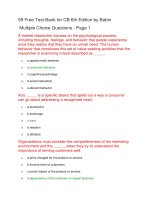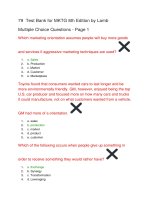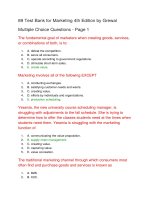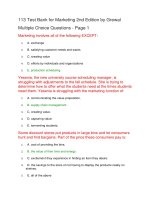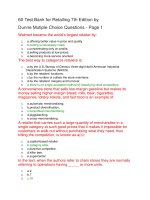TEST BANK FOR FUNDAMENTAL CONCEPTS AND SKILLS FOR NURSING 4TH EDITION BY SUSAN c DEWIT
Bạn đang xem bản rút gọn của tài liệu. Xem và tải ngay bản đầy đủ của tài liệu tại đây (31.87 KB, 11 trang )
Chapter 01: Nursing and the Health Care System
Test Bank
MULTIPLE CHOICE
1. Florence Nightingale’s contributions to nursing practice and education:
a. are historically important but have no validity for nursing today.
b. were neither recognized nor appreciated in her own time.
c. were a major factor in reducing the death rate in the Crimean War.
d. were limited only to the care of severe traumatic wounds.
ANS: C
By improving sanitation, nutrition ventilation, and handwashing techniques, Florence
Nightingale’s nurses dramatically reduced the death rate from injuries in the Crimean War.
DIF: Cognitive Level: Knowledge
TOP: Nursing History
MSC: NCLEX: N/A
REF: p. 2
OBJ: Theory #1
KEY: Nursing Process Step: N/A
2. Early nursing education and care in the United States:
a. were directed at community health.
b. provided independence for women through education and employment.
c. were an educational model based in institutions of higher learning.
d. have continued to be entirely focused on hospital nursing.
ANS: B
Because of the influence of early nursing leaders, nursing education became more
formalized through apprenticeships in Nightingale schools that offered independence to
women through education and employment.
DIF: Cognitive Level: Knowledge
TOP: Nursing History
MSC: NCLEX: N/A
REF: p. 2
OBJ: Theory #4
KEY: Nursing Process Step: N/A
3. In order to fulfill the common goals defined by nursing theorists (promote wellness,
prevent illness, facilitate coping, and restore health), the LPN must take on the roles of:
a. caregiver, educator, and collaborator.
b. nursing assistant, delegator, and environmental specialist.
c. medication dispenser, collaborator, and transporter.
d. dietitian, manager, and housekeeper.
ANS: A
In order for the LPN to apply the common goals of nursing, he or she must assume the
roles of caregiver, educator, collaborator, manager, and advocate.
DIF: Cognitive Level: Comprehension
TOP: Art and Science of Nursing
MSC: NCLEX: N/A
REF: p. 4
OBJ: Theory #2
KEY: Nursing Process Step: N/A
Copyright © 2014, 2009 Saunders, an imprint of Elsevier Inc.
1
From />
4. Although nursing theories differ in their attempts to define nursing, all of them base their
beliefs on common concepts concerning:
a. self-actualization, fundamental needs, and belonging.
b. stress reduction, self-care, and a systems model.
c. curative care, restorative care, and terminal care.
d. human relationships, the environment, and health.
ANS: D
Although nursing theories differ, they all base their beliefs on human relationships, the
environment, and health.
DIF: Cognitive Level: Comprehension
TOP: Nursing Theories
MSC: NCLEX: N/A
REF: p. 4
OBJ: Theory #2
KEY: Nursing Process Step: N/A
5. Standards of care for the nursing practice of the LPN are established by the:
a. Boards of Nursing Examiners in each state.
b. National Council of States Boards of Nursing (NCSBN).
c. American Nurses Association (ANA).
d. National Federation of Licensed Practical Nurses.
ANS: D
The National Federation of Licensed Practical Nurses modified the standards published by
the ANA in 2004 to better fit the role of the LPN.
DIF: Cognitive Level: Comprehension
TOP: Standards of Care
MSC: NCLEX: N/A
REF: p. 5
OBJ: Theory #2
KEY: Nursing Process Step: N/A
6. The LPN demonstrates an evidence-based practice by:
a. using a drug manual to check compatibility of drugs.
b. using scientific information to guide decision making.
c. using medical history of a patient to direct nursing interventions.
d. basing nursing care on advice from an experienced nurse.
ANS: B
The use of scientific information from high-quality research to guide nursing decisions is
reflective of the application of evidence-based practice.
DIF: Cognitive Level: Knowledge
TOP: Evidence Based Practice
MSC: NCLEX: N/A
REF: p. 5
OBJ: Theory #3
KEY: Nursing Process Step: N/A
Copyright © 2014, 2009 Saunders, an imprint of Elsevier Inc.
2
From />
7. Lillian Wald and Mary Brewster established the Henry Street Settlement Service in New
York in 1893 in order to:
a. offer a shelter to injured war veterans.
b. found a nursing apprenticeship.
c. provide health care to poor persons living in tenements.
d. offer better housing to low-income families.
ANS: C
Henry Street Settlement Service brought the provision of community health care to the
poor people living in tenements.
DIF: Cognitive Level: Comprehension
TOP: Growth of Nursing
MSC: NCLEX: N/A
REF: p. 2
OBJ: Theory #4
KEY: Nursing Process Step: N/A
8. An educational pathway for an LPN refers to an LPN:
a. learning on the job and being promoted to a higher level of responsibility.
b. moving from a maternity unit to a more complicated surgical unit.
c. obtaining additional education to move from one level of nursing to another.
d. learning that advancement requires consistent work and commitment.
ANS: C
By broadening the educational base, an LPN may advance and build a nursing career.
DIF: Cognitive Level: Knowledge
TOP: Nursing Education Pathways
MSC: NCLEX: N/A
REF: p. 6
OBJ: Theory #7
KEY: Nursing Process Step: N/A
9. When diagnosis-related groups (DRGs) were established by Medicare in 1983, the purpose
was to:
a. put patients with the same diagnosis on the same unit.
b. attempt to contain the costs of health care.
c. increase availability of medical care to the elderly.
d. identify a patient’s condition more quickly.
ANS: B
The purpose of instituting DRGs was to contain skyrocketing costs of health care.
DIF: Cognitive Level: Knowledge
TOP: Health Care Delivery
MSC: NCLEX: N/A
REF: p. 8
OBJ: Theory #10
KEY: Nursing Process Step: N/A
Copyright © 2014, 2009 Saunders, an imprint of Elsevier Inc.
3
From />
10. The advent of diagnosis-related groups (DRGs) required that nurses working in health care
agencies:
a. record supportive documentation to confirm a patient’s need for care in order to
qualify for reimbursement.
b. use the DRG rather than their own observations for patient assessment.
c. be aware of the specific drugs related to the diagnosis.
d. acquire cross-training to make staffing more flexible.
ANS: A
DRGs required that nurses provide more supportive documentation of their assessments
and identified patient needs to qualify the facility for Medicare reimbursement. Observant
assessment might also indicate another DRG classification and consequently more
reimbursement for the facility.
DIF: Cognitive Level: Comprehension
TOP: Managed Care
MSC: NCLEX: N/A
REF: p. 8
OBJ: Theory #10
KEY: Nursing Process Step: N/A
11. If a member of a health maintenance organization (HMO) is having respiratory problems
such as fever, cough, and fatigue for several days and wants to see a specialist, the person
is required to go:
a. directly to an emergency room for treatment.
b. to any general practitioner of choice.
c. directly to a respiratory specialist.
d. to a primary care physician for a referral.
ANS: D
Participants in an HMO must see their primary physician to receive a referral for a
specialist in order for the HMO to pay for the care.
DIF: Cognitive Level: Comprehension
TOP: Managed Care
MSC: NCLEX: N/A
REF: p. 9
OBJ: Theory #11
KEY: Nursing Process Step: N/A
12. An advantage of preferred provider organizations (PPOs) is that:
a. they make insurance coverage of employees less expensive to employers.
b. there are fewer physicians to choose from than in an HMO.
c. long-term relationships with physicians are more likely.
d. patients may go directly to a specialist for care.
ANS: A
The use of PPOs allows insurance companies to keep their premiums low and in turn
makes insurance coverage less expensive for the employers. There are usually more
physicians from which to choose than from a HMO, but long-term relationships between
physician and patient cannot be established easily. Patients still must see their primary
physician before being referred to other specialties.
DIF: Cognitive Level: Knowledge
TOP: Preferred Provider Organizations
MSC: NCLEX: N/A
REF: p. 6
OBJ: Theory #11
KEY: Nursing Process Step: N/A
Copyright © 2014, 2009 Saunders, an imprint of Elsevier Inc.
4
From />
13. After passing the National Council Licensure Examination for Practical Nurses
(NCLEX-PN), the nurse is qualified to take an additional certification in the field of:
a. pharmacology.
b. care of infants and children.
c. operating room technology.
d. community health.
ANS: A
After becoming an LPN, the nurse may apply for additional certification in pharmacology
or long-term care.
DIF: Cognitive Level: Knowledge
TOP: Educational Opportunities
MSC: NCLEX: N/A
REF: p. 6
OBJ: Theory #6
KEY: Nursing Process Step: N/A
14. Nursing interventions are best defined as activities that:
a. are taken to improve the patient’s health.
b. involve researching methods to maintain asepsis.
c. include the family in nursing care.
d. review guidelines for handling infectious wastes.
ANS: A
Interventions are actions taken to improve, maintain, or restore health.
DIF: Cognitive Level: Comprehension
REF: p. 4
OBJ: Theory #2
TOP: Art and Science of Nursing
KEY: Nursing Process Step: Planning
MSC: NCLEX: Health Promotion and Maintenance: prevention and early detection of disease
15. Nurse Practice Acts define the legal scope of an LPN’s practice, which are written and
enforced by:
a. the American Nurses Association.
b. the National Council Licensure Examiners.
c. each state.
d. each health care agency.
ANS: C
Each state writes and enforces the Nurse Practice Act, which defines the legal scope of
nursing practice.
DIF: Cognitive Level: Comprehension
TOP: Nurse Practice Act
MSC: NCLEX: N/A
REF: p. 5
OBJ: Theory #3
KEY: Nursing Process Step: N/A
Copyright © 2014, 2009 Saunders, an imprint of Elsevier Inc.
5
From />
16. Women volunteers were organized to give nursing care to the wounded soldiers during the
Civil War by:
a. Florence Nightingale.
b. Dorothea Dix.
c. Clara Barton.
d. Lillian Wald.
ANS: B
The Union government appointed Dorothea Dix, a social worker, to organize women
volunteers to provide nursing care for the soldiers during the Civil War.
DIF: Cognitive Level: Knowledge
TOP: Nursing History
MSC: NCLEX: N/A
REF: p. 2
OBJ: Theory #4
KEY: Nursing Process Step: N/A
17. The nursing theory presented by Sister Calista Roy is based on:
a. reduction of stress.
b. achievement of maximum level of wellness.
c. relief of self-care deficit.
d. adaptation modes.
ANS: D
Adaptation modes (physiologic, psychological, sociologic, and independence) are the basis
of the nursing theory of Sister Calista Roy.
DIF: Cognitive Level: Knowledge
REF: p. 4, Table 1-1
OBJ: Theory #2
TOP: Nursing Theories
KEY: Nursing Process Step:
N/A
MSC: NCLEX: N/A
18. The founding of the Red Cross is attributed to:
a. Lillian Wald.
b. Dorothea Dix.
c. Florence Nightingale.
d. Clara Barton.
ANS: D
Clara Barton founded the Red Cross.
DIF: Cognitive Level: Knowledge
TOP: Nursing History
MSC: NCLEX: N/A
REF: p. 2
OBJ: Theory #4
KEY: Nursing Process Step: N/A
Copyright © 2014, 2009 Saunders, an imprint of Elsevier Inc.
6
From />
19. The nursing theorist whose practice framework is based on 14 fundamental needs is:
a. Dorothy Johnson.
b. Jean Watson.
c. Virginia Henderson.
d. Martha Rogers.
ANS: C
Virginia Henderson’s nursing theory framework is based on 14 fundamental needs.
DIF: Cognitive Level: Knowledge
REF: p. 4, Table 1-1
OBJ: Theory #2
TOP: Nursing Theorists
KEY: Nursing Process Step:
N/A
MSC: NCLEX: N/A
20. The nursing theory that uses seven behavioral subsystems in an adaptation model is:
a. Betty Neumann.
b. Sister Calista Roy.
c. Dorothy Johnson.
d. Patricia Benner.
ANS: C
Dorothy Johnson’s practice framework is based on seven behavioral subsystems in an
adaptation model.
DIF: Cognitive Level: Knowledge
REF: p. 4, Table 1-1
OBJ: Theory #2
TOP: Nursing Theorists
KEY: Nursing Process Step:
N/A
MSC: NCLEX: N/A
21. The Standards of Clinical Nursing Practice are designed to direct LPNs to:
a. advance their nursing career.
b. seek a scientific basis for their interventions.
c. deliver safe, knowledgeable care.
d. a leadership role.
ANS: C
The Standards of Clinical Nursing Practice are designed to guide the LPN to deliver safe,
knowledgeable care.
DIF: Cognitive Level: Knowledge
REF: p. 5
OBJ: Theory #2
TOP: Nursing Standards
KEY: Nursing Process Step: N/A
MSC: NCLEX: Safe Effective Care Environment
Copyright © 2014, 2009 Saunders, an imprint of Elsevier Inc.
7
From />
22. A state’s Nurse Practice Act is designed to protect the:
a. physician.
b. nurse.
c. public.
d. hospital.
ANS: C
Nurse Practice Acts are designed to protect the public.
DIF: Cognitive Level: Knowledge
TOP: Nurse Practice Act
MSC: NCLEX: N/A
REF: p. 6
OBJ: Theory #5
KEY: Nursing Process Step: N/A
23. It is appropriate for practical nurses to provide direct patient care to persons in a hospital
under the supervision of a:
a. physician’s assistant.
b. registered nurse on the unit.
c. supervising nurse who is responsible for care on several units.
d. more experienced LPN on the unit.
ANS: B
Practical nurses provide direct patient care under the direct supervision of a registered
nurse, physician, or dentist.
DIF: Cognitive Level: Knowledge
TOP: Scope of Practice
MSC: NCLEX: N/A
REF: p. 6
OBJ: Theory #9
KEY: Nursing Process Step: N/A
24. An example of tertiary health care is _____ care.
a. hospice
b. restorative
c. emergency
d. home health
ANS: A
Tertiary health care includes extended care, chronic disease management, medical homes,
in-home personal care, and hospice care.
DIF: Cognitive Level: Comprehension
REF: p. 9, Box 1-2
OBJ: Theory #8
TOP: Health Care Services
KEY: Nursing Process Step:
N/A
MSC: NCLEX: N/A
Copyright © 2014, 2009 Saunders, an imprint of Elsevier Inc.
8
From />
COMPLETION
25. Preferred provider organizations (PPOs) use __________ to finance their services and pay
the physical cost of the service.
ANS:
capitated cost
The capitated cost is the set fee that is paid to the network for each patient enrolled to
finance its services.
DIF: Cognitive Level: Knowledge
TOP: Capitated Cost
MSC: NCLEX: N/A
REF: p. 9
OBJ: Theory #8
KEY: Nursing Process Step: N/A
26. In the United States, the Young Women’s Christian Association (YMCA) in New York
opened The __________ School, the first practical nursing school.
ANS:
Ballard
In 1892, the YMCA opened The Ballard School, a 3-month course in practical nursing that
was the first school of practical nursing.
DIF: Cognitive Level: Knowledge
TOP: Ballard School
MSC: NCLEX: N/A
REF: p. 2
OBJ: Theory #4
KEY: Nursing Process Step: N/A
27. Such health services as surgical procedures, restorative care, and home health care would
be classified as __________ care.
ANS:
secondary
Surgical procedures, restorative care, and home health are part of the many services
classified as secondary care.
DIF: Cognitive Level: Comprehension
REF: p. 9, Box 1-2
OBJ: Theory #10 TOP: Health Care Services
KEY: Nursing Process Step:
N/A
MSC: NCLEX: N/A
Copyright © 2014, 2009 Saunders, an imprint of Elsevier Inc.
9
From />
MULTIPLE RESPONSE
28. Characteristics of primary nursing include which of the following? (Select all that apply.)
a. Elimination of fragmentation of care between shifts
b. Evolved in the mid-1950s
c. Planning and direction performed by one nurse
d. Ancillary workers used to increase productivity
e. The care plan covering the entire day
f. Associate nurses taking over care and planning when the primary nurse is off duty
ANS: A, C, D, E, F
Primary care reduces fragmentation of care between shifts. Care is planned by one nurse to
cover a 24-hour period using ancillary workers to increase productivity. An associate nurse
may take on direction of care in the absence of the primary nurse.
DIF: Cognitive Level: Knowledge
TOP: Nursing Care Delivery
MSC: NCLEX: N/A
REF: p. 8
OBJ: Theory #8
KEY: Nursing Process Step: N/A
29. In 1991, the American Nurses Association (ANA) published the Standards of Clinical
Nursing Practice. These standards are designed to: (Select all that apply.)
a. set standards for safe nursing care delivery.
b. define the legal scope of practice.
c. establish state legal requirements for clinical practice.
d. protect the nurse, patient, and health care agency.
e. regulate the nursing profession.
f. define activities in which nurses may engage.
ANS: A, D, F
The Standards of Clinical Nursing Practice generally define activities in which nurses may
engage, set standards for nursing care and delivery, and thereby protect the nurse, patient,
and health care agency.
DIF: Cognitive Level: Knowledge
TOP: Nursing Practice
MSC: NCLEX: N/A
REF: p. 5
OBJ: Theory #2
KEY: Nursing Process Step: N/A
30. An example of the role of an LPN as a delegator is: (Select all that apply.)
a. changing a patient’s wound dressing.
b. assisting a patient to complete his or her bath.
c. assigning patient care tasks to certified nursing assistants.
d. requesting the housecleaning staff to mop the floor of a patient’s room.
e. instructing the unit secretary to page a physician to the floor.
ANS: C, D, E
Delegation under the scope of the practice of an LPN is the assignment of a certified
nursing assistant to certain nursing care or other non-medical staff to aspects of patient
care.
DIF: Cognitive Level: Comprehension
TOP: Art and Science of Nursing
MSC: NCLEX: N/A
REF: p. 4
OBJ: Theory #5
KEY: Nursing Process Step: N/A
Copyright © 2014, 2009 Saunders, an imprint of Elsevier Inc.
10
From />
31. During the Civil War, nursing schools offered education to women both in England and in
the United States. The schools in the United States differed from those in Europe because
in U.S. schools: (Select all that apply.)
a. students worked without pay.
b. the core curriculum was the same.
c. instruction was presented by physicians at the bedside.
d. the educational focus was on nursing care.
e. classes were held separately from the clinical experience.
ANS: A, C
In the United States, the students staffed the hospital and worked without pay. There were
no formal classes; education was achieved through work. There was no set curriculum, and
content varied depending on the type of cases present in the hospital. Instruction was done
at the bedside by the physician and therefore came from a medical viewpoint.
DIF: Cognitive Level: Comprehension
TOP: Early Nursing Education
MSC: NCLEX: N/A
REF: p. 2
OBJ: Theory #4
KEY: Nursing Process Step: N/A
Copyright © 2014, 2009 Saunders, an imprint of Elsevier Inc.
11
From />
